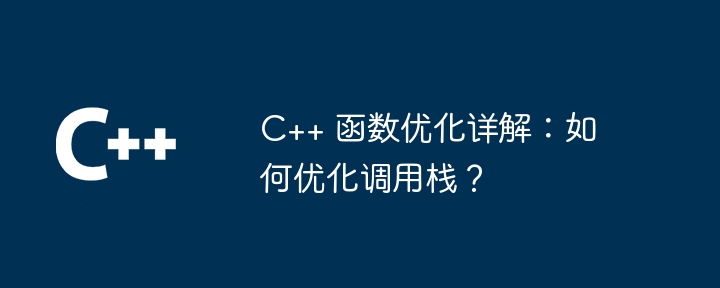
The call stack is a stacked record of function calls. The main factors affecting performance include context switching overhead, stack overflow risk and cache misses. Techniques for optimizing the call stack include reducing call depth, using tail recursion optimization, using inline functions, using local variables, and using smart pointers.

C function optimization: in-depth discussion of the call stack
The call stack is a stacked record of function calls in C. It is useful for It is crucial to trace the flow of program execution. However, the growth of the call stack can cause performance problems, especially for programs with deep call nesting.
How does the call stack affect performance?
Optimizing the call stack
There are several techniques that can be used to optimize the call stack in C:
1. Reduce Call depth: Reduce the depth of function nesting by breaking tasks into smaller functions to avoid excessive stack depth.
2. Use tail recursion optimization: The compiler can convert tail recursive functions into loops, thereby eliminating the need for a call stack.
3. Use inline functions: For small functions or functions that are called only once, the compiler can insert the function body directly into the call point, thus eliminating the function call overhead.
4. Use local variables: Store local variables in registers to reduce the cost of accessing stack memory.
5. Use smart pointers: Use smart pointers to automatically manage memory and avoid unnecessary stack allocation and destruction.
Practical case
In the following example, we will optimize a C program with nested recursive calls:
// 原始版本
int sum(int n) {
if (n == 0)
return 0;
else
return n + sum(n - 1);
}// 优化版本
int sum(int n) {
if (n == 0)
return 0;
int result = 0;
while (n != 0) {
result += n;
n--;
}
return result;
}In the second version , we use a loop to replace recursive calls, eliminating the need for a call stack.
Conclusion
By employing these optimization techniques, you can reduce call stack usage in C programs, thereby improving performance, avoiding stack overflows, and optimizing cache hit ratios.
The above is the detailed content of Detailed explanation of C++ function optimization: How to optimize the call stack?. For more information, please follow other related articles on the PHP Chinese website!
 What are the differences between c++ and c language
What are the differences between c++ and c language
 Recommended learning order for c++ and python
Recommended learning order for c++ and python
 Cost-effectiveness analysis of learning python and c++
Cost-effectiveness analysis of learning python and c++
 Is c language the same as c++?
Is c language the same as c++?
 Which is better to learn first, c language or c++?
Which is better to learn first, c language or c++?
 The difference and connection between c language and c++
The difference and connection between c language and c++
 C++ software Chinese change tutorial
C++ software Chinese change tutorial
 Cost-effectiveness analysis of learning python, java and c++
Cost-effectiveness analysis of learning python, java and c++




